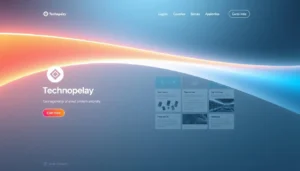Last Updated on: June 19, 2025
Creating an effective education website design requires a significant investment. The cost can vary widely based on the services needed, from simple website updates to comprehensive education web development projects.
Understanding the factors that influence web design cost is crucial for educational institutions looking to establish a strong online presence. Whether you’re looking to revamp your existing site or build a new one from scratch, knowing what to expect can help you budget more effectively.
As you consider your options, it’s essential to think about the overall goals of your website and how it will serve your audience. A well-designed education website can enhance user experience, improve engagement, and support your institution’s mission.
Key Takeaways
- Education website design costs vary based on project scope and complexity.
- Understanding web design costs helps in budgeting for your education website.
- Effective education web development enhances user experience and engagement.
- Clear goals are essential for a successful education website project.
- Budgeting for a website involves considering both initial costs and long-term maintenance.
Understanding the Education Website Landscape
The education sector encompasses a diverse range of institutions, each with unique website requirements. This diversity is reflected in the various types of education websites that serve different purposes and audiences.
Types of Education Websites
Education websites can be broadly categorized into several types, including K-12 school websites, higher education institution websites, online course platforms, and educational resource portals. Each type has its specific needs and functionalities. For instance, K-12 websites often require features like lunch menu portals and event calendars, while higher education websites may need more complex features such as online application systems and research portals.
Unique Requirements for Educational Institutions
Educational institutions have distinct requirements when it comes to their websites. These requirements can include responsive design to ensure accessibility across various devices, content management systems (CMS) for easy updates, and integrations with third-party tools for functionalities like online payments or student information systems. As noted by education expert John Smith, “A well-designed website is crucial for educational institutions to effectively communicate with their audience and provide a seamless user experience.”
“The website is often the first point of contact between an educational institution and its prospective students or parents. Therefore, it must be informative, user-friendly, and reflective of the institution’s brand.”
Understanding these unique requirements is essential for designing effective education websites that meet the specific needs of each institution.
How Much Does Web Design for Education Websites Cost?
When it comes to web design for education websites, understanding the costs involved is essential for institutions to budget effectively. The cost can vary widely based on factors such as the type of educational institution, the complexity of the website, and the technology used.
Average Price Ranges in the US Market
The average cost for web design services in the US market can range from $5,000 to $100,000 or more, depending on the scope and complexity of the project. For a basic website with standard features, costs can start at around $5,000 to $15,000. More complex projects, such as those requiring e-learning platforms or extensive custom features, can cost $50,000 to $100,000 or more.
Price Comparison: DIY vs. Professional Services
DIY web design solutions can be cost-effective, with some options available for under $100. However, these solutions often lack the customization and professional quality that educational institutions require. Professional web design services, while more expensive, offer tailored solutions that meet the specific needs of the institution, including custom features, responsive design, and integration with existing systems.
Typical Budget Allocation Breakdown
A typical budget for an education website can be broken down into several key areas: design and development, content creation, and ongoing maintenance. A general rule of thumb is to allocate 40-50% of the budget to design and development, 30-40% to content creation, and 10-20% to ongoing maintenance and updates.
Factors That Influence Education Website Design Pricing
Several critical elements play a role in determining the overall cost of an education website’s design. Understanding these factors is crucial for educational institutions to budget effectively for their online presence.
Website Size and Complexity
The size and complexity of an education website significantly impact its design cost. Larger websites with numerous pages, intricate navigation, and complex functionalities require more time and expertise to develop, thereby increasing the cost.
Custom Features and Functionality
Custom features such as learning management system (LMS) integration, student portals, and online application systems can enhance the functionality of an education website but also add to the design cost. The more customized the features, the higher the development time and cost.
Content Management System (CMS) Selection
The choice of CMS can also influence the design pricing. While open-source CMS platforms like WordPress or Drupal can be cost-effective, proprietary CMS solutions may require licensing fees, affecting the overall cost.
Responsive Design Requirements
With the increasing use of mobile devices, a responsive design that adapts to various screen sizes is essential. Implementing responsive design requires additional development effort, which can impact the overall pricing of the website design.
By understanding these factors, educational institutions can better plan and budget for their website design, ensuring they get a website that meets their needs without unexpected costs.
Common Pricing Models for Education Website Design
Pricing models for education website design are diverse, catering to different needs and budgets. Educational institutions have a range of options when it comes to developing their online presence.
Fixed Price Projects
Fixed price projects involve agreeing on a total cost for the entire project upfront. This model provides clarity and predictability for budgeting purposes. It’s particularly useful for well-defined projects with clear requirements.
Hourly Rate Billing
Hourly rate billing charges clients based on the actual time spent on the project. This model is beneficial for projects with evolving or unclear requirements, as it allows for flexibility in scope.
Retainer-Based Services
Retainer-based services involve paying a recurring fee for ongoing work or support. This model is ideal for institutions requiring continuous updates, maintenance, or support for their website.
Subscription-Based Solutions
Subscription-based solutions offer access to a website platform or service for a recurring fee. This model is gaining popularity, especially for institutions looking for cost-effective, scalable solutions with regular updates.
Each pricing model has its advantages, and the choice depends on the institution’s specific needs, budget, and project scope.
“The choice of pricing model can significantly impact the success of an education website project. It’s essential to choose a model that aligns with your institution’s needs and budget.”
Essential Features That Impact Education Website Costs
When designing an education website, several key features can impact the overall cost. Educational institutions require a variety of functionalities to effectively serve their students, staff, and community.
Learning Management System (LMS) Integration
A crucial feature for many educational institutions is the integration of a Learning Management System (LMS). This allows for the management of course content, student progress, and communication between instructors and learners. LMS integration can significantly impact the cost due to the complexity of integrating various LMS platforms such as Canvas, Blackboard, or Moodle.
Student Portal Development
Developing a student portal is another essential feature that can affect costs. This portal typically provides students with access to their grades, course materials, and other relevant information. The complexity of the portal, including user authentication and personalized content, influences the overall development cost.
Online Application Systems
Online application systems are vital for educational institutions, allowing prospective students to apply online. The development of such systems involves creating secure, user-friendly interfaces and integrating them with the institution’s database. This feature requires significant development effort, impacting the overall cost.
Virtual Tour Capabilities
Virtual tour capabilities are becoming increasingly popular, especially for higher education institutions. This feature allows prospective students to explore campuses remotely. The cost of implementing virtual tours can vary widely depending on the technology used, such as 360-degree photography or video.
Event Calendar and Registration Tools
An event calendar and registration tools are essential for promoting and managing events such as seminars, conferences, and open houses. The complexity of these tools, including integration with payment gateways for registration fees, affects their development cost.
Understanding these essential features and their impact on the cost can help educational institutions plan their website development projects more effectively.
Breaking Down the Cost: Design vs. Development
When it comes to education website design, understanding the distinction between design and development costs is crucial for budgeting. The overall cost of an education website can be significantly influenced by how these elements are prioritized and executed.
UI/UX Design Expenses
The cost of UI/UX design for education websites can vary widely, depending on the complexity of the design and the experience of the designers. On average, UI/UX design can cost between $5,000 and $20,000.
Front-End and Back-End Development Costs
Development costs, including both front-end and back-end development, are typically the most significant portion of the budget. Front-end development focuses on the user interface and user experience, while back-end development involves server-side logic, database integration, and API connectivity. The cost for development can range from $10,000 to $50,000 or more, depending on the complexity of the website.
Content Creation and Migration Pricing
Content creation and migration are critical components of launching an education website. The cost for content creation can vary based on the amount of content and the method of creation (e.g., text, images, videos). Migration costs depend on the complexity of transferring existing content to the new platform. On average, content creation and migration can cost between $3,000 and $10,000.
Additional Expenses to Consider in Your Budget
When budgeting for an education website, it’s crucial to consider additional expenses beyond the initial design and development costs. These expenses can significantly impact the overall cost and functionality of your website.
Domain Registration and Hosting
Domain registration and hosting are essential ongoing expenses. Domain registration typically costs between $10 to $35 per year, while hosting can range from $5 to $50 per month, depending on the type and quality of service.
SSL Certification
SSL certification is critical for securing your website and protecting user data. The cost of SSL certification varies, with prices starting at around $50 per year for basic certificates.
ADA Compliance and Accessibility Features
Ensuring your website is ADA compliant is not only a legal requirement but also enhances user experience. The cost of implementing accessibility features can vary widely, depending on the complexity of your site.
Ongoing Maintenance and Support
Ongoing maintenance is crucial for keeping your website secure, updated, and functioning properly. Costs can vary based on the service provider and the scope of work.
Training for Staff
Training staff to manage and update the website is an important consideration. This can be done through in-house training or external workshops, with costs varying accordingly.
Cost Comparison: K-12 vs. Higher Education Websites
When it comes to web design for educational purposes, the costs differ substantially between K-12 and higher education institutions. The complexity, functionality, and target audience of these websites play a significant role in determining their design and development costs.
Elementary and Secondary School Website Pricing
K-12 web design often focuses on simplicity and ease of navigation for both students and parents. The costs for these websites can range from $5,000 to $20,000, depending on the features required, such as online payment systems or student portals.
College and University Website Investment
Higher education web design, on the other hand, tends to be more complex, incorporating features like online course registration, faculty directories, and research portals. As a result, the costs can be significantly higher, ranging from $20,000 to $100,000 or more.
Private vs. Public Institution Considerations
The type of institution, whether private or public, also influences web design costs. Private institutions may require more customized features and designs, potentially increasing costs.
Measuring ROI: The Value of Your Education Website Investment
Measuring the ROI of an education website involves analyzing its effects on enrollment, administrative efficiency, and community engagement. To understand the true value of this investment, educational institutions must consider various metrics that demonstrate its impact.
Enrollment Impact Metrics
A key indicator of an education website’s ROI is its influence on enrollment numbers. This can be measured by tracking:
- Inquiry form submissions
- Application completions
- Conversion rates of prospective students
By analyzing these metrics, institutions can assess how effectively their website attracts and retains potential students.
Administrative Efficiency Gains
An education website can significantly streamline administrative tasks, leading to cost savings and improved operational efficiency. Metrics to consider include:
Community Engagement Benefits
An effective education website fosters a sense of community among students, parents, and alumni. Engagement metrics may include:
“A well-designed website is not just a tool, it’s a gateway to building a community around your institution.” – Education Technology Expert
- Website engagement metrics (time on site, pages per session)
- Social media integration and engagement
- Event participation and registration numbers
Competitive Advantage Assessment
In today’s digital age, a robust education website can be a significant differentiator. Institutions should assess how their website compares to competitors in terms of:
- Functionality and user experience
- Content quality and relevance
- Mobile responsiveness and accessibility
By evaluating these factors, educational institutions can ensure their website not only meets but exceeds the expectations of their audience, thereby maintaining a competitive edge.
Real-World Examples: Education Website Pricing Case Studies
Real-world examples provide valuable insights into the costs associated with education website design. By examining specific case studies, we can better understand the factors that influence education website pricing.
Small School District Website Redesign
A small school district in the Midwest undertook a website redesign to improve user experience and mobile responsiveness. The project involved customizing a CMS platform, integrating online application systems, and creating a responsive design. The total cost for this project was $45,000, with a breakdown of $15,000 for design, $20,000 for development, and $10,000 for content creation and migration.
Community College Portal Development
A community college on the West Coast developed a new portal to enhance student engagement and streamline information access. The portal included features such as LMS integration, student portal development, and event calendar tools. The total investment for this project was $120,000, distributed across design ($30,000), development ($60,000), and content creation ($30,000).
University Department Microsite
A university department required a microsite to showcase their research and programs. The microsite featured custom graphics and responsive design. The cost for this microsite was $18,000, with $8,000 for design and $10,000 for development.
Private School Complete Digital Presence
A private school opted for a complete digital presence, including a new website, online admission portal, and e-newsletter system. The total cost for this comprehensive project was $80,000, broken down into $25,000 for design, $40,000 for development, and $15,000 for content creation.
Conclusion: Making an Informed Investment in Your Education Website
Investing in an education website is a significant decision that can impact the success of an educational institution. By understanding the factors that influence education website design pricing, institutions can make an informed decision that aligns with their goals and budget.
A well-designed education website can enhance the learning experience, improve administrative efficiency, and foster community engagement. To maximize return on investment, it’s essential to consider the total cost of ownership, including ongoing maintenance and support.
By prioritizing features and functionalities that meet the needs of students, faculty, and staff, educational institutions can create a valuable online presence that supports their mission. Making an education website investment requires careful planning, but with the right approach, it can yield significant benefits.
FAQ
What is the average cost of web design for education websites in the US?
The average cost can vary widely, but generally, education websites can cost anywhere from $5,000 to $50,000 or more, depending on the complexity and features required.
What factors influence the pricing of education website design?
Factors such as website size, custom features, Content Management System (CMS) selection, and responsive design requirements all play a role in determining the final cost.
What are the different pricing models used for education website design?
Common pricing models include fixed price projects, hourly rate billing, retainer-based services, and subscription-based solutions, each with its own advantages and disadvantages.
How does the type of educational institution affect web design costs?
Different types of institutions, such as K-12 schools versus higher education institutions, have varying needs that can impact the overall cost of web design, with factors like complexity and required features influencing the final price.
What are some essential features that can impact education website costs?
Features like Learning Management System (LMS) integration, student portal development, online application systems, and virtual tour capabilities can all contribute to the overall cost of an education website.
What additional expenses should educational institutions consider when budgeting for their website?
Institutions should also budget for domain registration, SSL certification, ADA compliance, ongoing maintenance, and training for staff to ensure their website remains secure, accessible, and effective.
How can educational institutions measure the return on investment (ROI) of their website?
Institutions can measure ROI by tracking metrics such as enrollment impact, administrative efficiency gains, community engagement benefits, and competitive advantage assessment to understand the value of their website investment.
What is the difference in cost between DIY web design and professional services for education websites?
While DIY solutions may seem cost-effective upfront, professional services often provide a more comprehensive and tailored solution, potentially leading to greater long-term value and ROI, despite a higher initial cost.




